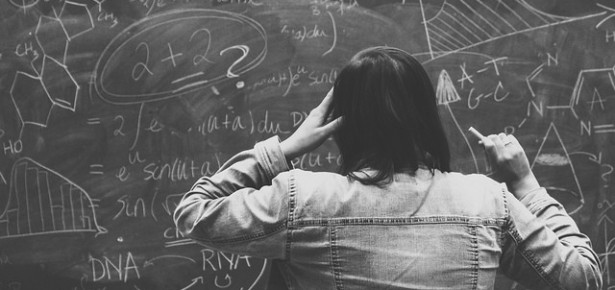
It is interesting to reflect upon how physics – a science heavily dependent on the language of mathematics – trains its future generations in that discipline. The role of mathematics in physics has changed profoundly in the last few decades. Quantum mechanics, condensed matter physics, particle physics, and other sub-disciplines now routinely work at levels of mathematical sophistication that were uncommon before. While one couldn’t say that physics at large has become more mathematical, many of its sub-disciplines have. This includes ‘applied’ fields, such as material-oriented condensed matter physics – think of the revolutionary advent of topological quantum matter – or computational physics. High school education has changed too, and not for the better, one must say. The only thing that has not changed is our entry level teaching system. Can recipes that have not been reformed in decades optimally prepare students for the physics of the 21st century?
In most departments the training starts with courses on ‘Mathematical Methods for Physicists’, where students learn the basics of integration, divs and grads, urgently required in the first year curriculum. But the role of mathematics in physics transcends that of a collection of methods. At universities where this truth is reflected in the curriculum, conceptual teaching is often outsourced to departments of mathematics. After all, who would be better prepared to teach mathematical concepts than mathematicians themselves?
The above system works, otherwise it would not be implemented at a majority of academic institutions. The question is if we can do better. We believe yes, and that the key to a modernized and more pedagogical approach to teaching mathematics in physics lies in a stronger integration of conceptual and methodological elements in the mathematics education of physicists by physicists.
What we have in mind is best explained on an example, the introduction of vectors early in the curriculum: the average beginner’s course starts from a hands-on introduction of vectors in Rn, with emphasis on n=3 to introduce the cross product, etc. This approach is well motivated by the requirements of first-year courses where low-dimensional mechanical systems are center stage. In parallel, a slowly-progressing mathematics course in linear algebra may introduce the foundations of linear spaces, but often in ways that make it hard for average students to see their relevance in physics. This way of introducing vectors, motivated by time pressure and the convenience of tapping into the teaching curriculum of mathematics, is far from ideal. Students conditioned into thinking of vectors as arrows in Rn generally struggle with the manifold manifestations of linear algebraic objects in physics: expansions in complete sets of functions, the linear-algebraic interpretations of Fourier and other integral transforms (which are key to not just analytic but also numerical work), the geometry of quantum mechanics, the solution of differential equations inspired by linear algebra, etc. The unifying framework linking all these is conveyed neither in an average ‘mathematical methods’ course, nor in a standard ‘linear algebra’ course taught by mathematicians.
There is a better way of getting started. At the very beginning, invest two or so weeks into a systematic, bottom-up discussion of algebraic foundations — sets, groups, number fields, linear spaces. Students trained in this way ‘see’ groups and vectors everywhere, in functions, matrices, Rn and Cn, matrix and Euclidean spaces, etc. For them, the expansion of a function(-vector) in a complete set of eigenfunctions on the sphere using the corresponding completeness relations – a subject reputed to be difficult in traditional teaching – feels completely natural. And as a welcome and important byproduct the foundations for the later introduction of non-vectorial elements of linear algebra – dual vectors, bilinear forms and more general forms of tensors required in relativity, field theory, or quantum information theory – are laid. Importantly, and perhaps unexpectedly, this more systematic way of introducing mathematics does not mean ‘slow’ teaching, quite the opposite. Of course, an approach introducing vectors as arrows in lecture no. 1 will have a certain head start. However, this carries only few weeks into the curriculum. At that stage, a comparison would show that students who have had the benefit of a solid introduction to linear algebra can move faster and with more confidence than those who had not. An even stronger tail wind sets in when the advanced concepts mentioned above enter the stage and easy reference to the interlinking framework of linear algebra greatly facilitates the progress of students.
Similar things could be said about integration theory, vector analysis, (differential) geometry, and other key disciplines of mathematics – conceptual and systematic introductions are rewarding investments which quickly pay off in fast and sustainable progress of students. Our belief in this principle is backed by experience. We have taught the reformed lecture course underlying our textbook about 10 times at two universities. Students trained in this way generally showed higher levels of confidence and proficiency in mathematics than those who went through the standard system. Remarkably, average and weak students are among those who benefit most. For them, it becomes easier to understand connections otherwise seen only by the best of the class. It should also be stressed that emphasis of mathematical concepts does not imply more abstraction. Yes, it does leads to more ‘hygiene’ in notation and to a language appearing to be ‘more mathematical’ than what is standard in physics courses. However, these elements are anchored in intuitive explanations, and hence aren’t perceived as abstract. They support students’ understanding, including that of concurrent courses in pure mathematics.
Encouraged by our uniformly positive experience we suggest a teaching reform at large, not just at our own universities. This was the principal motivation for the substantial work we put into converting our course into a textbook. It is meant to provide a template for what we hope may become a more rewarding introduction to the mathematics needed in contemporary physics.
Latest Comments
Have your say!